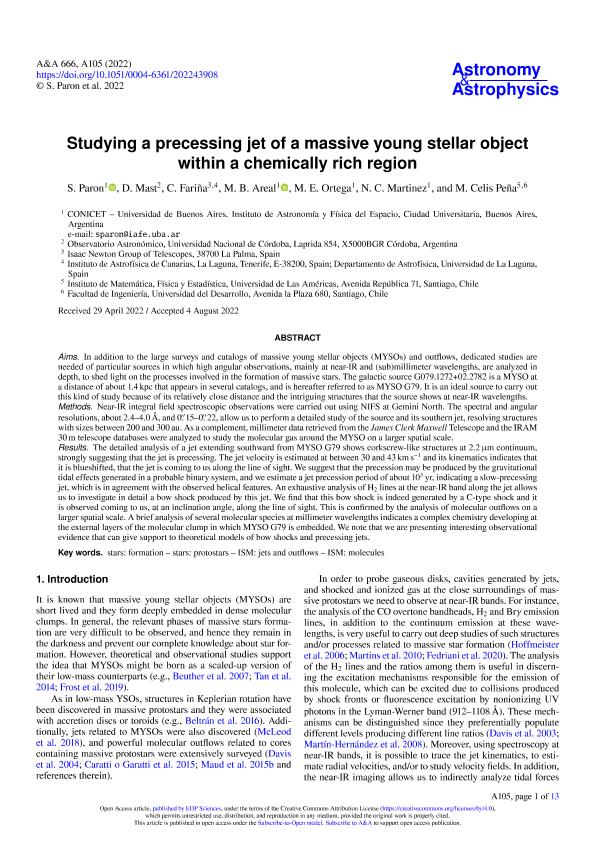Mostrar el registro sencillo del ítem
dc.contributor.author
Paron, Sergio Ariel

dc.contributor.author
Mast, Damian

dc.contributor.author
Fariña, C.
dc.contributor.author
Areal, María Belén

dc.contributor.author
Ortega, Martin Eduardo

dc.contributor.author
Martinez, Naila Constanza

dc.contributor.author
Celis Peña, M.
dc.date.available
2023-09-26T11:33:06Z
dc.date.issued
2022-10
dc.identifier.citation
Paron, Sergio Ariel; Mast, Damian; Fariña, C.; Areal, María Belén; Ortega, Martin Eduardo; et al.; Studying a precessing jet of a massive young stellar object within a chemically rich region; EDP Sciences; Astronomy and Astrophysics; 666; 10-2022; 1-13
dc.identifier.issn
0004-6361
dc.identifier.uri
http://hdl.handle.net/11336/213013
dc.description.abstract
Aims. In addition to the large surveys and catalogs of massive young stellar objects (MYSOs) and outflows, dedicated studies are needed of particular sources in which high angular observations, mainly at near-IR and (sub)millimeter wavelengths, are analyzed in depth, to shed light on the processes involved in the formation of massive stars. The galactic source G079.1272+02.2782 is a MYSO at a distance of about 1.4 kpc that appears in several catalogs, and is hereafter referred to as MYSO G79. It is an ideal source to carry out this kind of study because of its relatively close distance and the intriguing structures that the source shows at near-IR wavelengths. Methods. Near-IR integral field spectroscopic observations were carried out using NIFS at Gemini North. The spectral and angular resolutions, about 2.4- 4.0, and 0.′15- 0.′22, allow us to perform a detailed study of the source and its southern jet, resolving structures with sizes between 200 and 300 au. As a complement, millimeter data retrieved from the James Clerk Maxwell Telescope and the IRAM 30 m telescope databases were analyzed to study the molecular gas around the MYSO on a larger spatial scale. Results. The detailed analysis of a jet extending southward from MYSO G79 shows corkscrew-like structures at 2.2 μm continuum, strongly suggesting that the jet is precessing. The jet velocity is estimated at between 30 and 43 km s-1 and its kinematics indicates that it is blueshifted, that the jet is coming to us along the line of sight. We suggest that the precession may be produced by the gravitational tidal effects generated in a probable binary system, and we estimate a jet precession period of about 103 yr, indicating a slow-precessing jet, which is in agreement with the observed helical features. An exhaustive analysis of H2 lines at the near-IR band along the jet allows us to investigate in detail a bow shock produced by this jet. We find that this bow shock is indeed generated by a C-type shock and it is observed coming to us, at an inclination angle, along the line of sight. This is confirmed by the analysis of molecular outflows on a larger spatial scale. A brief analysis of several molecular species at millimeter wavelengths indicates a complex chemistry developing at the external layers of the molecular clump in which MYSO G79 is embedded. We note that we are presenting interesting observational evidence that can give support to theoretical models of bow shocks and precessing jets.
dc.format
application/pdf
dc.language.iso
eng
dc.publisher
EDP Sciences

dc.rights
info:eu-repo/semantics/openAccess
dc.rights.uri
https://creativecommons.org/licenses/by-nc-sa/2.5/ar/
dc.subject
ISM: JETS AND OUTFLOWS
dc.subject
ISM: MOLECULES
dc.subject
STARS: FORMATION
dc.subject
STARS: PROTOSTARS
dc.subject.classification
Astronomía

dc.subject.classification
Ciencias Físicas

dc.subject.classification
CIENCIAS NATURALES Y EXACTAS

dc.title
Studying a precessing jet of a massive young stellar object within a chemically rich region
dc.type
info:eu-repo/semantics/article
dc.type
info:ar-repo/semantics/artículo
dc.type
info:eu-repo/semantics/publishedVersion
dc.date.updated
2023-09-22T13:39:40Z
dc.journal.volume
666
dc.journal.pagination
1-13
dc.journal.pais
Francia

dc.journal.ciudad
Paris
dc.description.fil
Fil: Paron, Sergio Ariel. Consejo Nacional de Investigaciones Científicas y Técnicas. Oficina de Coordinación Administrativa Ciudad Universitaria. Instituto de Astronomía y Física del Espacio. - Universidad de Buenos Aires. Facultad de Ciencias Exactas y Naturales. Instituto de Astronomía y Física del Espacio; Argentina
dc.description.fil
Fil: Mast, Damian. Universidad Nacional de Córdoba. Observatorio Astronómico de Córdoba; Argentina. Consejo Nacional de Investigaciones Científicas y Técnicas; Argentina
dc.description.fil
Fil: Fariña, C.. Universidad de La Laguna; España
dc.description.fil
Fil: Areal, María Belén. Consejo Nacional de Investigaciones Científicas y Técnicas. Oficina de Coordinación Administrativa Ciudad Universitaria. Instituto de Astronomía y Física del Espacio. - Universidad de Buenos Aires. Facultad de Ciencias Exactas y Naturales. Instituto de Astronomía y Física del Espacio; Argentina
dc.description.fil
Fil: Ortega, Martin Eduardo. Consejo Nacional de Investigaciones Científicas y Técnicas. Oficina de Coordinación Administrativa Ciudad Universitaria. Instituto de Astronomía y Física del Espacio. - Universidad de Buenos Aires. Facultad de Ciencias Exactas y Naturales. Instituto de Astronomía y Física del Espacio; Argentina
dc.description.fil
Fil: Martinez, Naila Constanza. Consejo Nacional de Investigaciones Científicas y Técnicas. Oficina de Coordinación Administrativa Ciudad Universitaria. Instituto de Astronomía y Física del Espacio. - Universidad de Buenos Aires. Facultad de Ciencias Exactas y Naturales. Instituto de Astronomía y Física del Espacio; Argentina
dc.description.fil
Fil: Celis Peña, M.. Universidad del Desarrollo; Chile
dc.journal.title
Astronomy and Astrophysics

dc.relation.alternativeid
info:eu-repo/semantics/altIdentifier/url/https://www.aanda.org/10.1051/0004-6361/202243908
dc.relation.alternativeid
info:eu-repo/semantics/altIdentifier/doi/http://dx.doi.org/10.1051/0004-6361/202243908
Archivos asociados
